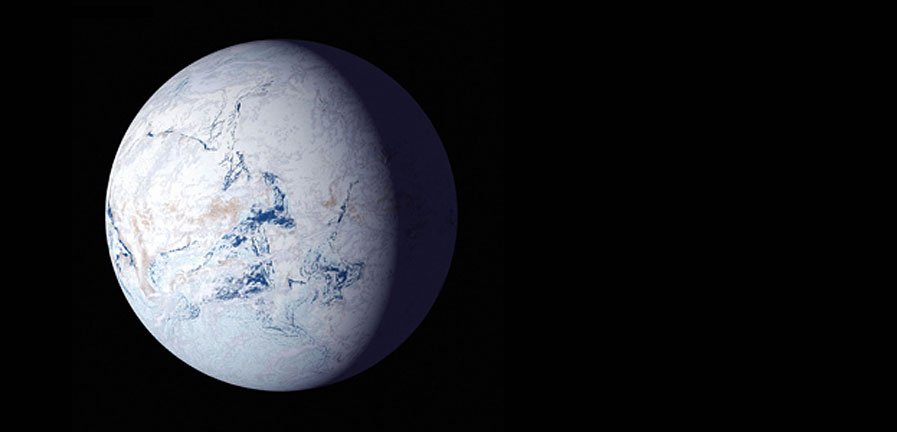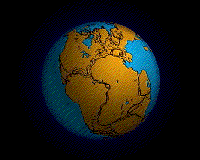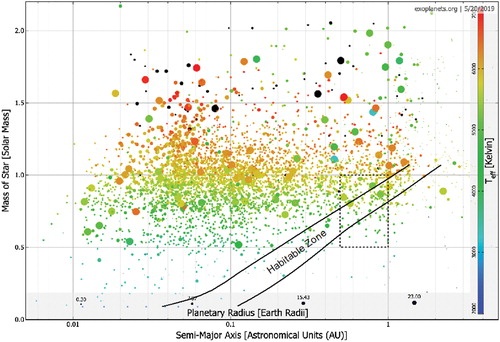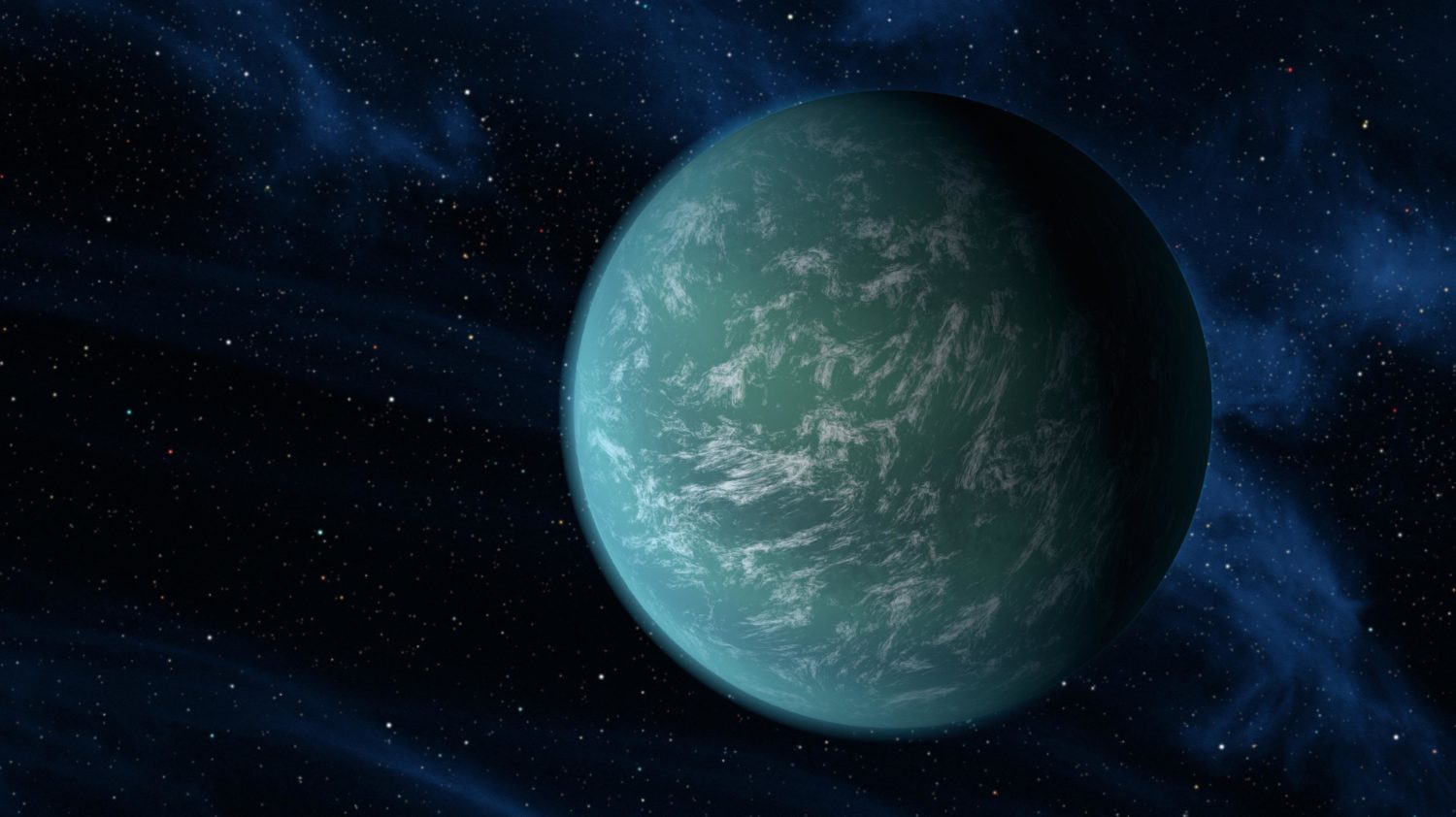REMINDER: – Universe Today will be hosting an interview with Dr. Dirk Schulze-Makuch, co-author of the research featured in this article, on Thursday October 15th, 2020 at 8:30am PT. Click the video below to watch live or to see the recorded stream afterward
Out Earthing Earth
What planet is this?

If you said Hoth, that’s a good guess. But, it’s actually Earth depicted in one of two known “snowball” states. The entire planet’s surface was locked beneath glacial ice during the Cryogenian Period 650 million years ago and during the Huronian Glaciation 2 – 2.4 billion years ago.
When considering habitability, we tend to use Earth as THE gold standard of planets in the Universe. But even Earth has experienced compromised habitability due to cataclysmic events or climate change. Furthermore, what if there are planets that out Earth the planet Earth at being Earth-like – better optimized for the evolution of diverse and complex life? In a new study, authors Dirk Schulze-Makuch, professor of the Centre for Astronomy and Astrophysics at Technical University Berlin; Astrophysicist René Heller at the Max Planck Institute for Solar System Research; and Edward Guinan, professor at Villanova University’s Department of Astronomy say:
“The fact that Earth is teeming with life makes it appear odd to ask whether there could be other planets in our galaxy that may be more suitable for life.”
Schulze-Makuch, Heller, and Guinan 2020
But that what the authors have set out to find – planets even more habitable than Earth or “Superhabitable”
Planet Hunting
The study examined 4000+ confirmed planets and planet candidates featured in the KOI (Kepler Object of Interest) database in search of superhabitable worlds. Kepler is a planet hunting telescope launched in 2009 searching for planets outside our solar system or “exoplanets.” Though unlikely that our Sun was the only star with planets, we didn’t have definitive proof of exoplanets until 1992 when we found several orbiting neutron star B1257+12 . Within just a few years of launch, Kepler discovered thousands more using the “transit method.” Kepler detects the shadows cast by distant worlds as they cross our view of their parent stars (a transit) blocking some of the starlight. Kepler sampled a portion of the sky near constellations Cygnus and Lyra and confirmed that the Universe probably has even more planets than it does stars. Of course, we want to know, can life exist on those worlds? Are they habitable? Are they potentially more habitable than our own world?

Life As We Know It…
When defining “habitable”, we’re really talking about habitability for life as we know it as that’s the only example we have. The authors used a list of environmental conditions that constrain the biochemistry of life on Earth including temperature, pH, water, oxygen, pressure, radiation, and the ranges in which life survives in each. For example, some creatures living a the 11,100m depth of the Marianas Trench, deepest point in our oceans, are subjected to pressure a thousand times greater than on the planet’s surface and yet life exists in both places. However, we can’t yet measure all these conditions on a distant world with the same detail of our own planet. Instead, we try to determine what general prerequisites led to Earth’s habitability and apply them to distant worlds. What we CAN see is the type of star an exoplanet is orbiting, if the exoplanet orbits its star at a distance to maintain a temperature conducive to liquid water (referred to as the habitable zone), the mass of the exoplanet, and estimate the age of the exoplanet and host star.
Superhabitable Conditions
The Parent Star:
Our Sun is a dwarf class G star or “dG” sometimes referred to as a yellow dwarf. Because we’re here and we orbit this star, one might conclude that class G stars are ideal for the evolution of complex life. But, complex life required over 3 billion years of evolution. Technological life required 4 billion. Looking at our Sun’s lifecycle, we barely made it. Our Sun has 5 billion years left before exhausting its hydrogen fuel but along the way it is continuing to warm and will vaporize Earth’s oceans in just one billion more – a fraction of the total time it took for us to evolve. More massive stars; class F, A, B, and O; exhaust their hydrogen at much faster rates – some in 5 billion years or even just a few million years – leaving little room for life to evolve…or even begin. Stars less massive than our Sun, class K and M, live longer providing more time for evolution on the planets in their solar systems. However, class M stars, capable of burning on the order of hundreds of billions to trillions of years, come with caveats. Their low energy output requires planets to orbit so closely to maintain temperatures conducive to liquid water that they become “tidally locked.” One side of the planet is locked by gravity to always face the star – just as our Moon is tidally locked to the Earth. Temperature variations across a tidally locked planet would be extreme from one side to the other. Furthermore, the proximity of the planet to the star leaves it vulnerable to intense bursts of solar radiation from superflares and solar storms. So M is probably out. That leaves class K stars, the weight class just below G which, according to the authors, “might well offer the most benign environments for superhabitable planets.” Statistically this is good news as K stars make up a greater percentage of our galaxy’s stars than G – 12% vs 8%.
Mass:
In addition to not orbiting the most optimal star, Earth might not be the optimal mass for a terrestrial life-bearing planet either. More mass means more surface area. More surface area means more space for life to evolve as well as a thicker atmosphere owing to increased gravity. But you reach a critical limit. Planets that are more than 1.5 times the mass of Earth might actually be distant gas giants classified as “Mini Neptunes.” If they are in fact terrestrial worlds above 1.5 Earth masses, the increased gravity may impede the mechanics of plate tectonics, the motion of Earth’s landmasses, essential for the recycling of surface nutrients through earthquakes and volcanism (a process Mars lacks for example). Plate tectonics also evenly distribute land and water. In the past, Earth’s lone super continent Pangea featured in-land deserts as the central regions of the continent were distant from ocean water resulting in poorer habitability than today’s continent configuration. A larger mass planet also locks more heat within its core which drives tectonic activity for a longer time. In addition, a spinning molten planetary core generates a protective magnetic field around the planet just as our magnetic field protects us from solar radiation (visible during aurora). The authors settle on a terrestrial planet 1.5 times the mass of Earth and approximately 10% larger.

c. USGS Public Domain
Temperature:
A planet’s temperature and temperature variation are mostly a function of distance from the parent star as well as tilt of the planet’s axis. For an ideal temperature and stable axial tilt, a planet needs to reside within the star’s habitable zone where liquid water would be present at the surface (as with Earth) and feature a large moon. The Moon’s gravitational pull on Earth reduces the amount that our planet “wobbles.” Like a spinning top, our Earth wobbles about its axis meaning that, in about 13,000 years, the North Star will be the star Vega and not Polaris as the direction the North Pole points drifts across the sky. Without the anchoring effect of the Moon, the wobbling of Earth’s axis would be much greater. Great shifts in the planet’s axial tilt could trigger extreme temperature and climate changes resulting in mass extinction events. We also know the warmest and wettest places on Earth are where we find the greatest biomass and biodiversity – namely the rainforests. Warmer and wetter eras of Earth’s history were also synonymous with great explosions of life such as the Carboniferous Period 350 million years ago when the average global temperature was 5 degrees warmer than today. So, we’re looking for wet exoplanets, in the habitable zone, with a mean global temperature 5 degrees warmer than present day Earth, and which feature a large moon.
Age:
Life began about 700 million years after the Earth’s formation. But eons more time was required for complex multicellular life to evolve. Given more time, evolution has more opportunities to try out ways of doing life. It’s unclear what the optimal time for complex life to evolve is, but you want as much time as you can get before the core of the planet cools or the parent star exhausts its fuel. In addition, too much time increases the chance a given planet is subjected to random cataclysmic events like comet impacts. The authors select an age of 5-8 billion years vs Earth’s 4.5 billion.
With these conditions, we arrive at a superhabitable planet:
- Terrestrial planet orbiting within the habitable zone of a K class dwarf parent star – vs Earth’s G dwarf star
- 5-8 billion years old – vs Earth’s 4.5 billion years
- 1.5 times Earth’s mass and 10% larger than Earth
- Mean surface temperature 5 degrees Celsius warmer – similar to Earth’s Carboniferous Period
- A moist atmosphere of 25 – 30% O2 concentration – also similar to Earth’s Carboniferous atmospheric O2 concentrations (currently we are at 21%)
- Plate tectonics resulting in the recycling of the planet’s surface nutrients and evenly distributed water and land. By virtue of active plate tectonics, the planet also likely features a rotating molten core generating a protective magnetic field
- Hosts a large moon 1-10% the mass of the planet and orbiting at 10-100 planetary radii distance – Earth’s Moon is 1.2% Earth’s mass and orbits at about 60 Earth radii
So, are there any planets that meet the conditions!? It’s a solid…maybe. We can’t measure all these criteria from the distances we are observing with current technologies. We can’t, for example, yet determine if an exoplanet features active plate tectonics or hosts a moon. But we can measure the mass of an exoplanet, whether it orbits within the habitable zone, estimate its age, and classify the parent star. Scanning the 4000+ Kepler planets for superhabitable criteria, the authors find 24 terrestrial candidates that meet at least some of the conditions. 9 orbit K stars, 16 are between 5-18 billion years old, and 5 are within a 10 degree range of optimal temperature. Of the 24, ONE meets all the observable criteria, KOI 5715.01, which orbits a K class orange dwarf star roughly 3000 light years from Earth.

Is Anyone Home?
While the candidates might feature the prerequisites for superhabitability, we don’t know if they are actually inhabited. While we know what conditions life (as we know it) needs to flourish, we don’t know what conditions are required for the origin of life. However, once the ball is rolling, life appears driven toward complexity.
In related research also written by Dirk Schulze-Makuch and joined by MIT’s William Bains, the two argue that if life begins on a planet, evolution inevitably leads toward complex, macroscopic forms given habitable environmental conditions and enough time. Schulze-Makuch and Bains reviewed “key innovations” or major evolutionary milestones of life on Earth. These milestones occurred “many times independently in very different groups of organisms” suggesting these innovations are neither rare nor unique in the evolutionary process toward progressively more complex life. And if these great leaps happened many times on our own planet, independent of species or location, perhaps similar milestones could occur on other worlds as well. Key Innovations were also catalyzed by conditions common to other worlds. For example, photosynthesis is a logical evolutionary leap as the most readily abundant source of energy to life would be starlight at a planet’s surface. We could expect then that alien life has also evolved to photosynthesize. Other proceeding innovations were oxygen producing bacteria that enriched our atmosphere’s O2 content, complex internal cell structure, complex genetic coding, multicellularity, large multicellular organisms, and finally intelligence leading to technological intelligence. Of all the innovative steps of life, the two we don’t fully understand are the origin of life itself and the development of technological intelligence – the beginning and most recent. Outside of these two innovations, the authors conclude that, given enough time, “where life has arisen and sufficient energy flux exists, we are confident that we will find complex, animal-like life.” This may not be technological animal life, but IF life did begin on a world, and especially if that world exhibits superhabitability, there is a high probability that complex animal life resides on that world if the evolution of life on Earth is any indication. And that’s…wow.
Presently none of the superhabitable candidates reside within a hundred light years meaning they are difficult to study in detail. But given coming advances in telescopes like the James Webb Space Telescope and the Starshade Project, if a closer superhabitable candidate is discovered the authors encourage us to take a closer look saying that
“…with regard to the search for extrasolar life, potentially superhabitable planets may deserve higher priority for follow-up than most Earth-like planets.”
Schulze-Makuch, Heller, and Guinan 2020
In the meantime, there is ONE world we know of that has life. In terms of habitability, we’re doing a lot of damage. It took billions of years for conditions to set the stage for our arrival on Earth. We’re quickly reversing all that. Let’s cherish Earth with the same awe and reverence we would grant its cousin were we to find it among the stars.
More to Explore:
Universe Today Interview with Dirk Schulze-Makuch
In Search for a Planet Better than Earth: Top Contenders for a Superhabitable World – Schulze-Makuch, Heller, Guinan 2020 (Originating Publication)
Just How Bad are Superflares to a Planet’s Habitability? – Universe Today
James Webb is Working Perfectly! On the Ground. Next Trick: Doing it from Space – Universe Today
Effects of Extreme Obliquity Variations on the Habitability of Exoplanets – Amstrong et al 2014
It’s Over for Kepler. The Most Successful Planet Hunter Ever Built is Finally out of Fuel and Has Just Been Shut Down – Universe TodayA Balloon Mission that Could Try to Confirm Life on Venus – Universe Today

